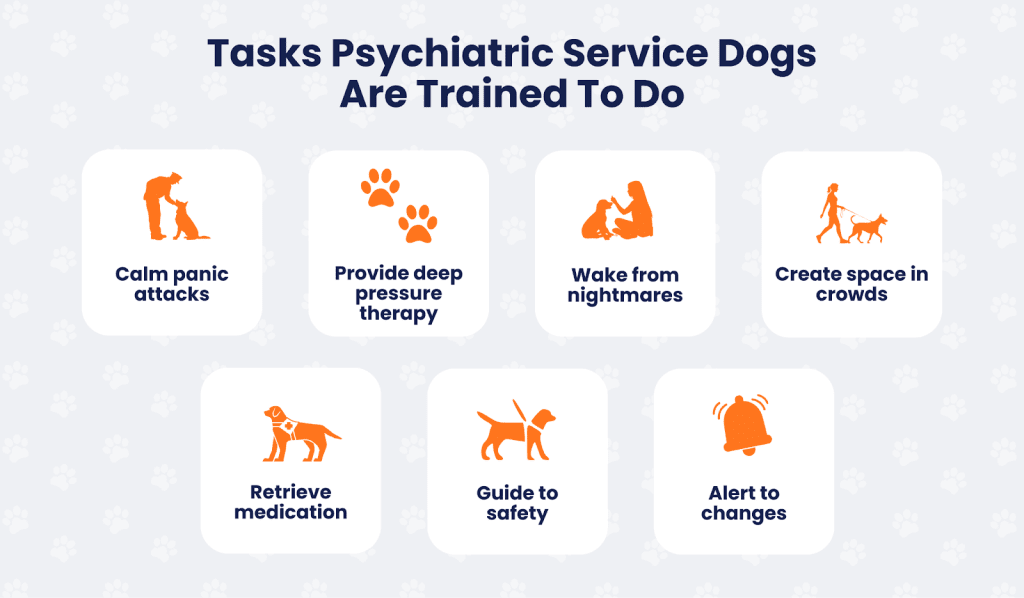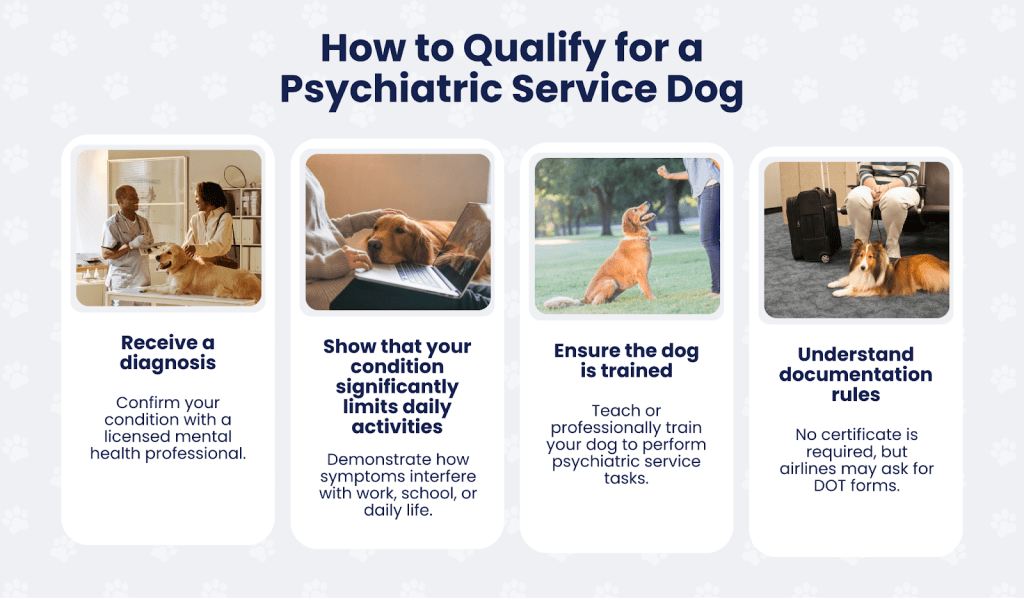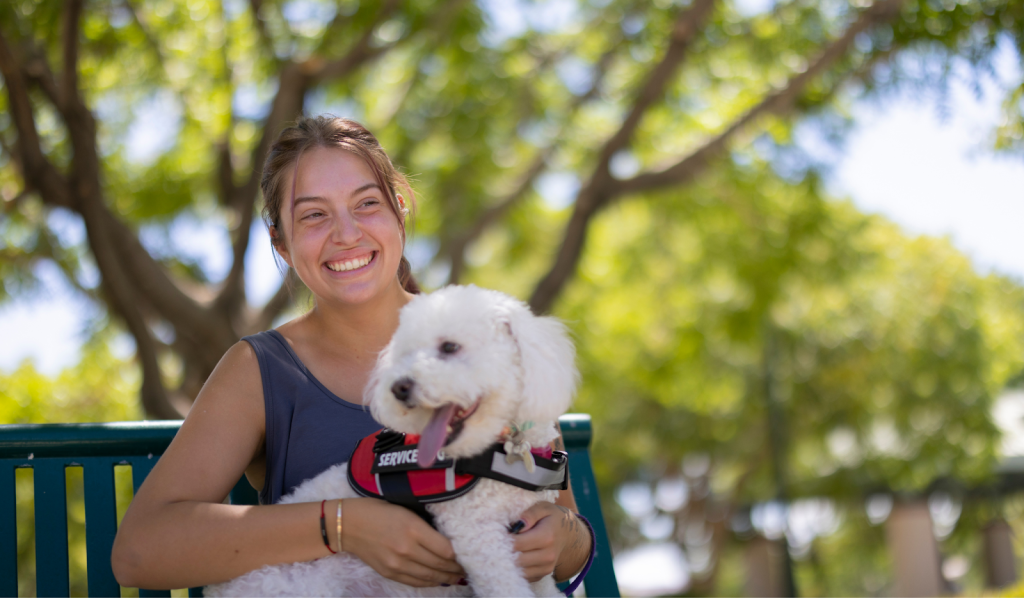If you live with anxiety, post-traumatic stress disorder (PTSD), depression, or another mental health condition, you know that symptoms can appear at unpredictable times. Therapy and medication provide support, but sometimes you need help in the moment. You may need something or someone that keeps you grounded, helps you stay safe, and allows you to function in daily life. That is where a Psychiatric Service Dog, or PSD, can make a difference.
A PSD is more than a pet. Unlike Emotional Support Animals, these dogs are trained to carry out specific tasks that reduce the impact of psychiatric symptoms. They are recognized under federal law as service animals, which means they can go almost anywhere their handler goes. For many people, a PSD offers stability, confidence, and independence.
Key Takeaways
- Psychiatric Service Dogs (PSDs) are specially trained to perform tasks that directly assist with psychiatric symptoms such as panic attacks, dissociation, or severe anxiety.
- They are legally protected under the ADA, FHA, and ACAA, which grant access to housing, workplaces, public spaces, and air travel.
- PSDs are best suited for individuals whose psychiatric conditions significantly affect daily functioning and independence.
- Training and responsibilities are ongoing, requiring daily care, task reinforcement, and proper behavior in public settings.
- The bond between a PSD and handler can be life-changing, offering stability, confidence, and a greater sense of safety in everyday life.
What Is a Psychiatric Service Dog?

A Psychiatric Service Dog is a specially trained service animal that helps people living with psychiatric or mental health conditions. Their role goes far beyond companionship. They are trained to perform specific actions that support their handler during moments of distress. For example, a PSD might interrupt a panic attack or help you reorient during an episode of dissociation.
Because PSDs qualify as service animals under the Americans with Disabilities Act, they have public access rights. You are legally allowed to bring them into restaurants, stores, workplaces, schools, and even on airplanes.
Who Can Benefit from a Psychiatric Service Dog?
A PSD may be right for you if your condition limits your ability to manage daily life. These dogs are often recommended for:
- Veterans or trauma survivors living with PTSD
- People with severe anxiety or panic disorder who need grounding in public
- Individuals with major depressive disorder who struggle with motivation and daily routines
- People with bipolar disorder, especially during mood episodes
- Those living with schizophrenia or dissociative conditions who need safety support
- Students or professionals whose symptoms affect their performance at school or work
If your symptoms significantly interfere with daily activities, a PSD may help restore balance and independence.
What Tasks Can Psychiatric Service Dogs Perform?

The unique value of a PSD lies in their training. These are some of the most common tasks:
- Interrupting panic attacks by pawing, nudging, or applying pressure
- Providing deep pressure therapy by lying across your lap to create calm
- Waking you from nightmares or night terrors
- Creating space in crowds to reduce triggers
- Retrieving medication or providing reminders
- Guiding you to safety during disorientation or dissociation
- Alerting you to emotional or behavioral changes before you notice them
Each PSD is trained for the specific needs of their handler, which means no two are alike.
Legal Rights and Protections for PSDs
The law offers strong protections for people with PSDs.
- The Americans with Disabilities Act gives PSDs the right to enter nearly all public places
- The Fair Housing Act ensures that landlords must allow PSDs even in housing with no pets policies
- The Air Carrier Access Act requires airlines to allow PSDs to travel in the cabin with their handler
With these protections come responsibilities. Your PSD must be well trained, under control, and not disruptive in public.
How to Qualify for a Psychiatric Service Dog

Qualifying for a PSD involves a few important steps:
- Get a psychiatric diagnosis from a licensed mental health professional
- Confirm that your condition substantially limits your ability to perform daily activities
- Work with a professional trainer or train your own dog to perform service tasks
- Learn the rules on documentation. PSDs do not need a letter for public access, although airlines may require Department of Transportation forms for flights
Training a Psychiatric Service Dog
Training is essential to ensure that a PSD can fulfill its role. This includes:
- Basic obedience and socialization
- Task training tailored to the handler’s psychiatric needs
- Public access training to ensure the dog behaves in restaurants, airports, and busy places
Some people train their PSD themselves, which is allowed under the ADA. Others rely on professional trainers or service dog programs. Common breeds for PSDs include Labradors, Golden Retrievers, German Shepherds, and Poodles because of their intelligence and calm temperament.
Responsibilities and Challenges of Owning a Psychiatric Service Dog
A Psychiatric Service Dog can provide life-changing support, but ownership comes with responsibilities that go beyond ordinary pet care. Understanding these realities helps ensure a successful partnership and long-term stability for both you and your dog.
Daily Care and Training
Your PSD will rely on you for consistent structure. This means providing exercise, grooming, and nutrition, but also reinforcing the specialized tasks they’ve learned. Even well-trained dogs need ongoing practice to stay sharp and reliable in public.
Public Etiquette and Advocacy
Living with a PSD often requires educating others. You may need to remind businesses of your rights under the ADA or calmly handle questions from strangers. Just as important, your dog must remain under control and behave appropriately in all settings. Disruptive or aggressive behavior can limit access rights.
Lifestyle Adjustments
Having a PSD means planning around them in travel, work, and daily routines. While airlines, schools, and workplaces must accommodate PSDs, you will often need to provide documentation, prepare for crowded environments, and consider how your dog adapts to new situations.
Emotional and Practical Commitment
Owning a PSD is not a short-term solution. It requires patience during setbacks, dedication to your dog’s well-being, and a willingness to adjust your own habits. The bond you build is deeply rewarding, but it thrives only when both handler and dog are consistently supported.
Psychiatric Service Dog vs Emotional Support Animal
It is easy to confuse PSDs with Emotional Support Animals, but the differences are significant.
An Emotional Support Animal provides comfort through its presence. ESAs do not receive specialized training, and they do not have the same legal protections as PSDs.
A Psychiatric Service Dog is trained to perform targeted tasks that directly assist with psychiatric symptoms. PSDs are recognized as service animals under federal law. They can accompany their handler in public places, housing, and airplanes, which ESAs cannot.
If you simply feel better when a pet is nearby, an ESA may be enough. If you require a dog that can step in during moments of crisis or instability, a PSD may be the right choice.
Everyday Life With a Psychiatric Service Dog
Life with a PSD requires commitment but can be life-changing. You will need to care for your dog daily, maintain training, and advocate for your rights in public.
In return, you may gain more independence, fewer psychiatric crises, and a sense of safety that allows you to fully participate in everyday life. For many handlers, the bond with a PSD becomes one of the most supportive relationships in their lives.
If you need an ESA letter for an Emotional Support Animal, we at Emma & Buddy make the process simple by connecting you with licensed therapists who provide legitimate documentation. Our goal is to ensure you and your companion have the recognition, support, and peace of mind you deserve.












